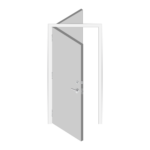My Decoded articles are a great resource for technical information on a specific code requirement, but after writing this column for 13 years, some articles need an update. I have edited this one based on current codes and standards.
This post was published in

 I often field questions on products that are not specifically covered in the codes and standards, and it’s not always possible to point to evidence in the model codes or referenced standards to “prove” that these products are acceptable. But the absence of a specific reference in these publications does not mean that these materials are prohibited.
I often field questions on products that are not specifically covered in the codes and standards, and it’s not always possible to point to evidence in the model codes or referenced standards to “prove” that these products are acceptable. But the absence of a specific reference in these publications does not mean that these materials are prohibited.
For example, past editions of NFPA 80 – Standard for Fire Doors and Other Opening Protectives did not specifically mention whether terminated stops (AKA hospital stops) or delayed action closers were allowed to be used on fire door assemblies. Code change proposals were submitted several years ago and these products are now addressed in the standard, but with a code-development cycle of 3 years, it was a long-term commitment. The same issue has arisen with products designed and tested to address excess clearance on fire door assemblies.
Even if a code change is approved on the first try, it can be many years before the new language is officially adopted in a particular jurisdiction. For example, changes were made to the 2016 edition of NFPA 80 to address products that are listed to fill holes in fire doors, and door bottoms or sweeps to mitigate oversized undercuts. However, this edition of the standard was not referenced by the model codes until the 2018 editions, and some jurisdictions have not yet adopted the 2018 codes. Most notably, CMS – the Centers for Medicare and Medicaid Services is still enforcing the 2012 edition of NFPA 101 – Life Safety Code, which references the 2010 edition of NFPA 80. Because of the extended process to adopt new versions of the codes and standards, it may take more than a decade for a change made to a standard to be adopted by reference.
So what happens between the time when a new product is developed (or someone notices that a material or method is not addressed) and a code change goes into effect? The National Fire Protection Association (NFPA) codes and standards cover this situation in a section called “Equivalency.” In NFPA 80 and NFPA 101, the Equivalency section states that the NFPA codes and standards are not intended to prevent the use of new/improved devices, systems, or methods that are superior to the prescriptive requirements of these publications. It is the manufacturer’s responsibility to provide information to the authority having jurisdiction (AHJ), which demonstrates equivalency.
This technical documentation could include testing laboratory results based on fire tests and engineering studies, descriptive information about the products, installation methods, required maintenance, and any limitations on the use of the material or method. The equivalency process ensures that the continuous process of product development does not conflict with the current standards. If the information provided is in order and demonstrates equivalency, the system, method, or device is typically approved. The term “approved” is defined by NFPA as “acceptable to the authority having jurisdiction.” When the material or method is approved as equivalent – meeting the intent of the code or standard, it is recognized as being code-compliant. An equivalent protection method is intended to provide a level of safety that is greater than or equal to the requirements of the code or standard.
The International Building Code (IBC) addresses this situation in a section called Alternative Materials, Design, and Methods of Construction and Equipment. Again, the code is not intended to prohibit new materials and methods for which the code does not include prescriptive information, as long as it has been approved. The IBC defines the term “approved” as “acceptable to the building official.” The IBC lists research reports and test results as potential evidence that the proposed design complies with the intent of the code with regard to quality, strength, effectiveness, fire resistance, durability, and safety. If the building official does not approve a submitted design, the IBC requires the building official to state in writing the reasons why the alternative was not approved.
The term “building official” used in the IBC is defined as “The officer or other designated authority charged with the administration and enforcement of this code, or a duly authorized representative.” Because the NFPA codes and standards are enforced by a wide range of jurisdictions and approval agencies the term “authority having jurisdiction (AHJ)” is defined by NFPA as “An organization, office, or individual responsible for enforcing the requirements of a code or standard, or for approving equipment, materials, an installation, or a procedure.” An AHJ may be a federal, state, local, or regional department or others having statutory authority, including a fire chief, fire marshal, or other fire prevention personnel, a building official, a labor or health department, or other inspector. An AHJ could also be an insurance inspector, accreditation or certification agency personnel, commanding officers or departmental officials for government facilities, or even a property owner or the owner’s agent.
The committees responsible for the model codes and referenced standards attempt to address the most current industry standards, practices, and technology. However, this is an ever-evolving industry, and it’s impossible to ensure that every product, assembly, or practice is addressed. To manage this potential time lapse, the codes and standards give the power to the AHJ or building official to evaluate and approve the alternate arrangements. Although a proposed installation may not meet the exact criteria in a code or standard, it will often be approved if the proper documentation of equivalency is provided.
You need to login or register to bookmark/favorite this content.










Looks good by me.
Lori
In healthcare, equivalent items to the Life Safety Code are measured by NFPA 101A, “Guide on Alternative Approaches to Life Safety”, which the 2001 edition is considered the version to be used for the 2000 LSC. The NFPA 101A has Fire Safety Evaluation System (FSES) worksheets that assigns numerical values to existing features of fire safety, and a negative number is assigned to the feature that is deficient. The numbers are then run through a formula and if the result is a positive number, then there is considered an equivalent level of safety. If the number is negative, then there is not an equivalent level of safety.
In healthcare, FSES equivalencies are only approved by the Centers for Medicare & Medicaid Services (CMS) where federal Medicare funds are received by the healthcare organization (nearly all hospitals in the US). CMS considers the FSES equivalency process to be equal to that of the waiver process, so the healthcare organization is required to demonstrate an unreasonable hardship in resolving the deficiency before CMS will approve the equivalency or waiver request.
All makes sense. Lays out the concept and practice of applying equivalency pretty clearly to me.
Lori –
This is an well written article. Since you start off with a “hospital stop” issue (a healthcare item), perhaps you could include Brad Keyes’ comments somewhere in the article?
With all of these barricade devices popping up everywhere… could there actually be a “Downside” to equivalency? I mean, all you have to do is get an AHJ to “approve” the equivalency of a barricade device and “poof” the next thing you know, items that have no place in our industry are being used… just food for thought.
That’s an interesting thought. There are so many ways that barricade devices are not compliant with the model codes that I would not think an AHJ would consider them equivalent, but you never know.
– Lori
Would if the doors get stuck closed what are the wires connected to the doors